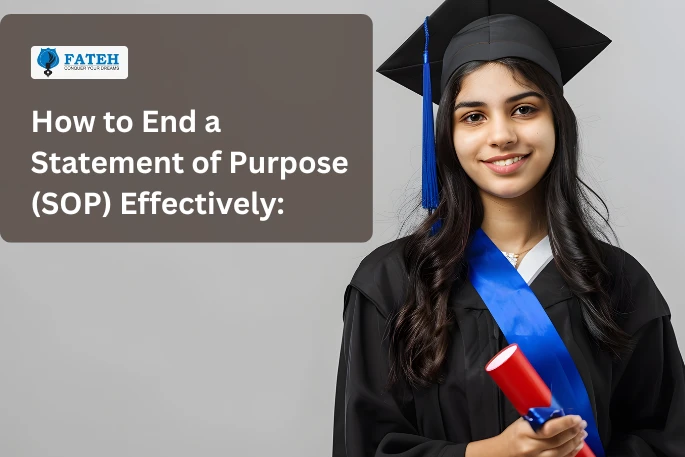Introduction
The conclusion of a Statement of Purpose (SOP) is often overlooked, yet it holds the power to shape the final impression you leave on an admissions committee. While much attention is given to crafting a compelling introduction and outlining achievements, the way you end your SOP can be the difference between a memorable application and one that fades into the background. A well-written conclusion not only reinforces your key points but also demonstrates your confidence, clarity of purpose and genuine enthusiasm for the programme you are applying to.
In this blog, we will explore why the ending matters so much, discuss the nuances of how to end SOP effectively and share practical examples and tips drawn from both expert advice and lesser-known insights. By the end, you will have a toolkit of strategies to help your SOP stand out for all the right reasons.
Before we dive into the specifics of crafting a compelling ending, let us look at what makes a conclusion truly effective and how you can approach this pivotal section with confidence and originality.
Understanding the Purpose of a Strong SOP Conclusion
The conclusion of a Statement of Purpose is more than just a formality; it is the final opportunity to shape how the admissions committee perceives you. While the body of your SOP details your journey, achievements and motivations, the ending is where you tie everything together and leave a lasting impression. Admissions officers often read dozens, if not hundreds, of applications, so how to end SOP effectively can determine whether your story resonates or fades into the background.
A strong conclusion does several things at once. It succinctly reiterates your professional experiences and career aspirations, reminding the committee of your suitability for the programme. It connects your goals to the specific university or course, demonstrating that you have researched and understood how this opportunity aligns with your ambitions. This section is also where you can express genuine enthusiasm for joining the academic community, making your application feel personal and memorable.
Key elements of a successful SOP conclusion include clarity, conciseness and relevance. Avoid repeating details from earlier sections; instead, focus on reinforcing your fit, your vision for the future and your excitement about the next step. Mastering how to end SOP can help ensure your application stands out for all the right reasons.
As we explore the art of crafting a compelling ending, let us consider the subtle techniques and thoughtful choices that can transform a standard conclusion into a memorable finale.
Crafting a Compelling Ending for Your SOP
A memorable SOP conclusion does far more than simply round off your essay—it brings your narrative full circle, leaving the admissions committee with a clear sense of your motivations and future direction. One effective technique for how to end SOP is to briefly reference the story or motivation you introduced at the start, creating a sense of harmony and closure. This subtle echo not only reinforces your journey but also demonstrates thoughtful structure and self-awareness.
Next, restate your central purpose in applying, but avoid mere repetition. Instead, reframe your goals in light of what you have shared, highlighting how the programme will help you achieve your ambitions. For instance, you might say, “My academic and professional experiences have prepared me to contribute meaningfully to [university name], and I am eager to deepen my expertise in [field] as I work towards my long-term goal of [career aspiration].” This approach demonstrates both clarity and conviction.
Another key element in how to end SOP is to affirm your enthusiasm for joining the institution. Express genuine excitement about the learning environment, faculty, or unique opportunities, but keep your tone sincere and specific. Avoid generic statements or clichés, and steer clear of simply summarising earlier points. Instead, focus on the future—how you hope to grow, contribute and make a meaningful impact.
Common blunders include vague or overly grand statements, repetition of earlier content and lack of personal touch. A strong conclusion is concise, forward-looking and tailored to the programme, ensuring your application lingers in the reader’s mind.
To illustrate these principles in action, let us look at some real examples of effective SOP conclusions and examine what makes them memorable..
Examples of Effective SOP Conclusions
Examining strong SOP conclusions can shed light on how to end SOP in a way that resonates with admissions committees. Consider this example from an applicant to a Mechanical Engineering PhD programme:
“As I reflect on developing a blueberry-sensing AGV from concept to deployment, I am reminded of the fulfilment that comes from driving innovation and learning new methodologies. A PhD at Gotham University is the ideal environment for me to advance my research skills, contribute to the field of robotics and pursue my long-term goal of promoting sustainable manufacturing. I look forward to leveraging the academic connections and technical knowledge I will gain, ultimately leading impactful projects in the future.”
This conclusion stands out because it circles back to the applicant’s initial story, restates their purpose, and aligns their ambitions with what the university offers. It is forward-looking, specific and personal, all while maintaining a concise tone.
Another compelling example comes from a Master’s applicant in Education:
“Having moved beyond the ‘troubled student’ label, I am now committed to helping students in Chinese high schools through research in developmental psychology. The Ed.M. at Gotham will equip me to effect real change, and I am eager to collaborate with faculty whose work inspires me. My diverse background ensures my compatibility with the programme, and I am excited to contribute to the university’s community.”
Here, the conclusion is tailored, optimistic and demonstrates a clear understanding of how to end SOP with both conviction and authenticity.
By dissecting these examples, it becomes evident that a strong conclusion is never generic. Instead, it is crafted to reinforce the applicant’s journey, aspirations and fit with the chosen programme.
As we turn our attention to common mistakes, it is equally important to recognise what to avoid so your efforts in how to end SOP are not undermined by easily preventable errors.
Common Mistakes to Avoid in SOP Endings
Many applicants, even those with impressive credentials, stumble when it comes to how to end SOP in a way that is both memorable and authentic. One of the most frequent errors is relying on clichés or generic language, such as “Thank you for considering my application” or “It has always been my dream to study at your esteemed university.” These phrases do little to distinguish your application and can come across as insincere or formulaic.
Another common misstep is tacking on a “why this university” paragraph at the very end, rather than weaving your motivations and fit throughout the SOP. Admissions committees are quick to spot essays that save personalisation for the conclusion, and this approach often feels like an afterthought rather than a genuine connection. Similarly, empty flattery—using terms like “world-class faculty” or “renowned programme”—can undermine your credibility, especially if you have not demonstrated specific knowledge of the university’s unique offerings.
Applicants sometimes end their SOPs abruptly or with a summary that merely repeats earlier points, missing the chance to leave a lasting impression. To avoid these mistakes, focus on crafting a conclusion that circles back to your introduction, reinforces your main purpose and provides a forward-looking statement. Thoughtful attention to how to end SOP will ensure your application closes on a note of clarity and conviction.
Now that we have explored what to avoid, let us turn our attention to how you can craft a conclusion that truly stands out and lingers in the minds of the admissions committee.
Crafting a Memorable Conclusion for Your SOP
A memorable SOP conclusion is one that feels both natural and purposeful, echoing your journey while leaving a distinct impression on the reader. To achieve this, begin by subtly referencing your introduction—perhaps by revisiting a personal anecdote or theme you opened with. This sense of circularity provides closure and demonstrates narrative skill, a technique often found in standout applications. When considering how to end SOP, focus on reaffirming your central purpose and connecting your aspirations directly to the programme, showing clear alignment between your goals and what the university offers.
Actionable steps include restating your commitment to your field, highlighting how the specific programme will help you achieve your ambitions and expressing genuine enthusiasm for joining the academic community. Avoid vague statements; instead, mention concrete ways you hope to contribute or grow, such as engaging with particular research groups or leveraging unique university resources.
Your tone should remain confident and sincere, steering clear of overused phrases or empty flattery. Instead, let your individuality and motivation shine through, ensuring your conclusion is personal and forward-looking. Mastering how to end SOP in this way will help your application linger in the minds of the admissions committee, setting you apart from the crowd.
By applying these strategies, you can transform your SOP’s ending from a mere formality into a powerful statement that encapsulates your journey and ambition.
Conclusion
A well-crafted SOP conclusion is more than just a final paragraph—it is your last chance to connect your story, ambitions and personality with the admissions committee. Throughout this blog, we have explored how to end SOP in a way that is personal, purposeful and memorable, drawing on nuanced strategies and real-world examples. By avoiding common errors, weaving your narrative full circle and expressing your motivation with sincerity, you can ensure your application stands out in a competitive field. Remember, a compelling ending does not simply summarise; it leaves the reader with a sense of your potential and your readiness for the journey ahead.
If you are seeking tailored guidance on how to end SOP or want expert feedback on your application, Fateh Education is here to help. Our experienced team understands what top universities look for and can support you in crafting a Statement of Purpose that truly reflects your strengths and aspirations. Reach out to Fateh Education today and take the next confident step towards your study abroad dreams.
FAQs
Maintaining coherence between your SOP’s introduction and conclusion is vital for a polished, unified narrative. Refer back to a theme, anecdote or question you introduced at the start, showing how your journey has come full circle. This approach demonstrates thoughtful structure and helps your story feel complete, leaving the reader with a sense of closure and purpose.
While it is polite to be appreciative, ending your SOP with a generic thank you note can weaken your impact. Instead, show your enthusiasm by expressing what excites you about the programme or how you hope to contribute. This leaves a stronger, more memorable impression than a simple expression of gratitude.
To make your SOP conclusion unique, incorporate a personal anecdote, highlight your future aspirations and mention specific ways you align with the programme. Avoid clichés and generic statements; instead, focus on authentic details that showcase your individuality and genuine motivation.
Yes, but do so with intention. Briefly reiterate your goals, weaving them naturally into your final remarks. Connect your ambitions to the opportunities offered by the programme, ensuring your conclusion feels forward-looking and relevant rather than repetitive.


